ALREADY A PAID SUBSCRIBER? SIGN IN
ALREADY A PAID SUBSCRIBER? SIGN IN
Life has begun to stir, the snowdrops suddenly visible and lighting the gloom. Over the last ten years I have been adding to a ribbon that is designed to draw us out into the landscape. It starts in the hedges close to the house and skips down the ditch in a stop-start rhythm where I have found the places that they like to be. Not too wet and with just enough shadow to keep the grass down once they have come into leaf and do their bulking. They reappear then down by the stream to run its length and ensure we walk our stretch whilst we can still get to the water in winter. The gesture demands generosity and commitment to adding to the trail, like a conversation you come back to, but is never really done.
We need to think expansively beyond the curtilage of the garden, where the land takes over and we could never nor want to control all that we see. Although the touch by necessity needs to be light in these wilder places, it should also feel generous. Not in a conspicuous way, but right because you have found a niche and then followed it. The big moves always start with a small one. Finding the place that a plant likes to be and understanding why and then going with it.
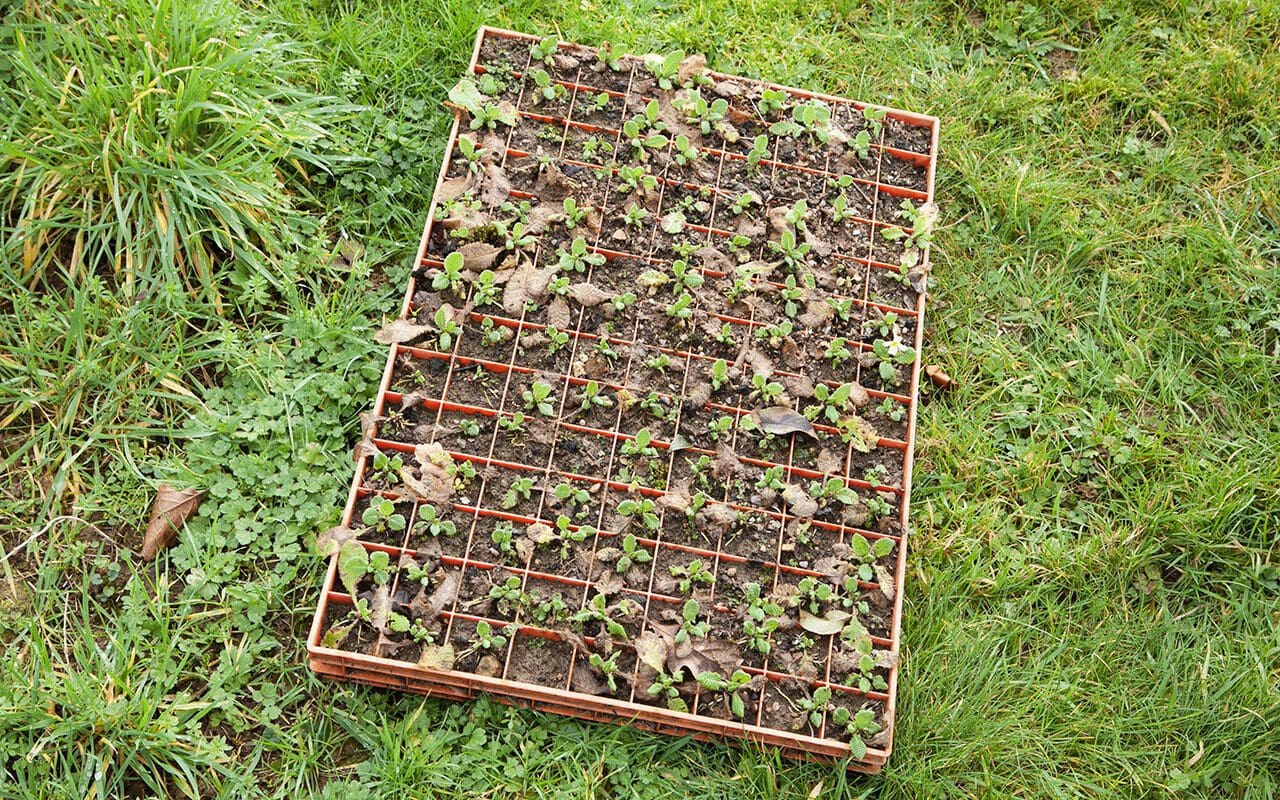
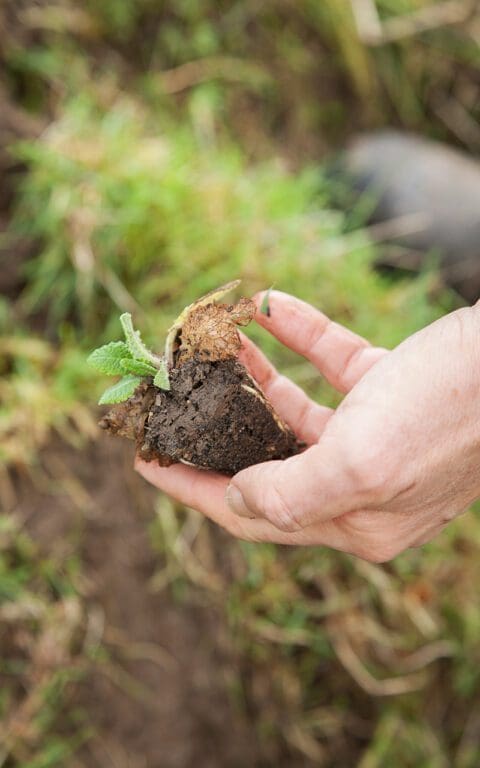
Working at scale in these wilder places demands both patience and persistence. Neither feel forced or hard won when the mother plants begin to seed. The primrose splits from five years ago came from a colony that was hiding amongst a cage of brambles. We fenced the ditch to keep out the livestock, cut away the brambles and the primroses proliferated on the hummocky slopes where each had its little microclimate. The splits – taken early in April not long after the primroses had peaked – were found a similar position and, where we hit the sweet spot, they are showing their happiness there in seedlings. The seedlings slowly erase your hand. The regular rhythm you try to avoid when planting, but cannot help but read when you look back on what you have done. The seedlings skip a beat, their seed taken to a new place by ants. The ones that come through feel right for having found their own place.
By its very nature my role as the ‘gardener’ of these natural processes cannot help but want for a little more. So where splits have proved to be too slow – the mother plants taking time to bulk – I have taken to collecting seed. This is ripe in June, but you have to watch carefully then as the plants are often consumed in the shadow of summer vegetation. The seed is best sown fresh or it begins to enter a period of dormancy that is hard to break. Fresh seed germinates erratically, some in the late summer and over autumn, but the majority in the spring after it has had time for the frost to do its work.
I sow three or four plug trays each year (between 300-400 plants) casting the seed over the tray and then top-dressing with sharp grit to protect it. Sowing annually means that I have a relay of seedlings on the go. Seedlings are left in the trays for 18 months and planted out just about now, when there is time for their early growth to get ahead of the competition. This year the seedlings are going into the steep banks up behind the house, where the sheep have opened up the ground with heavy grazing and poaching. The slope is south-facing and primroses love to bask in early sunshine. Here the bees find them early too. The summer cover of the grassland that rises up around them will keep them in the shade they like later.
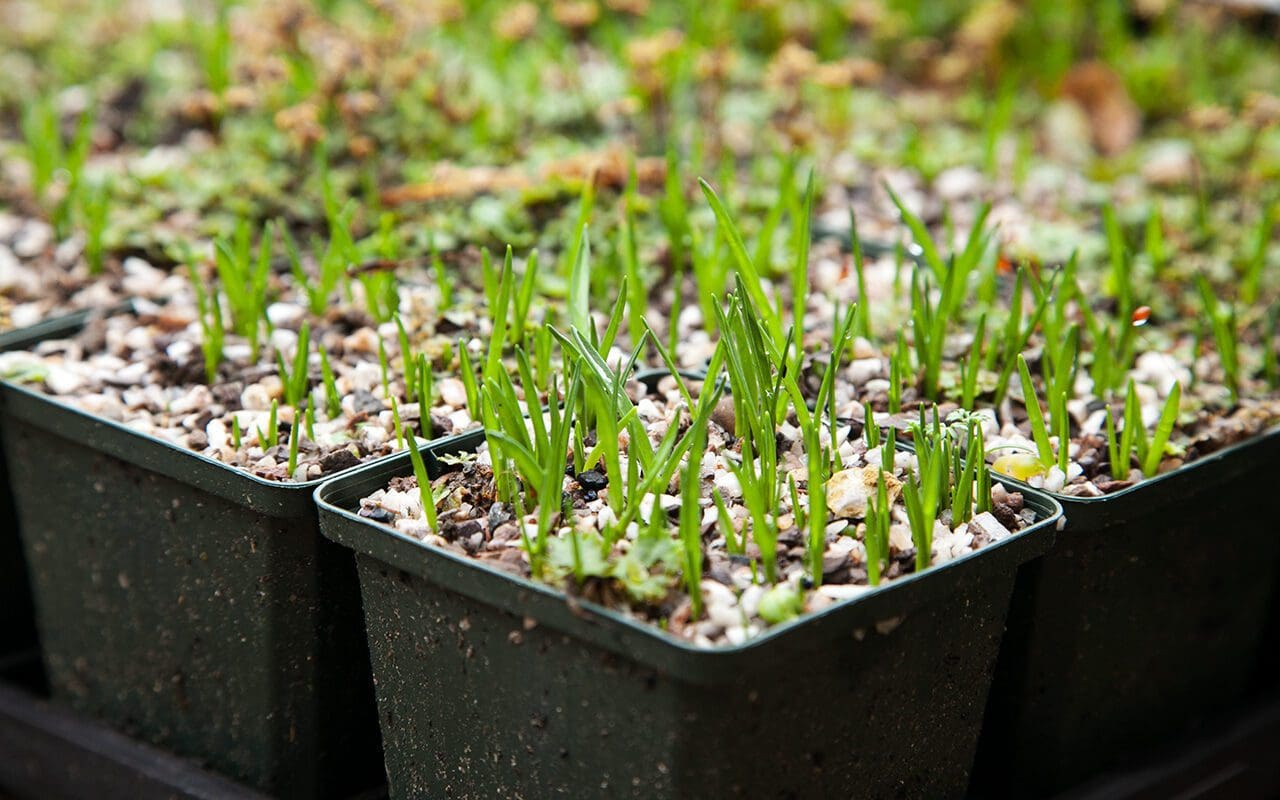
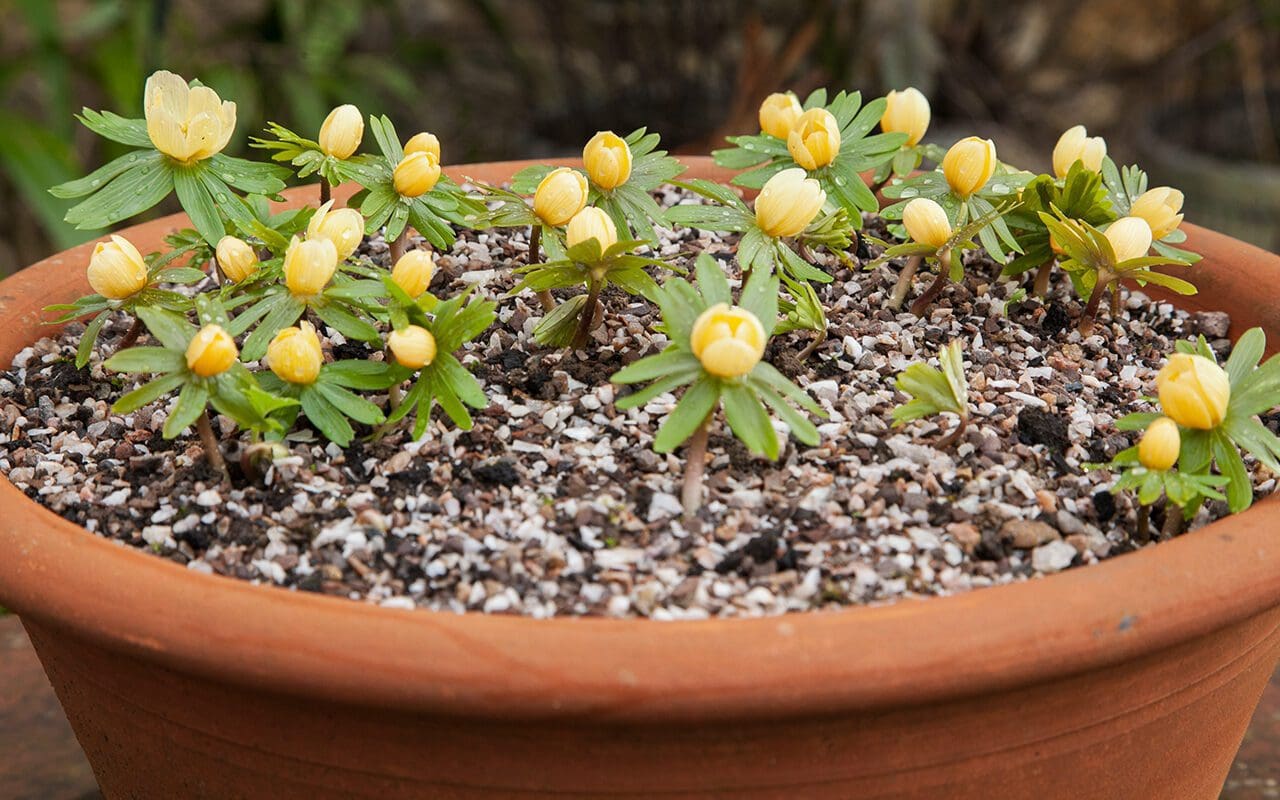
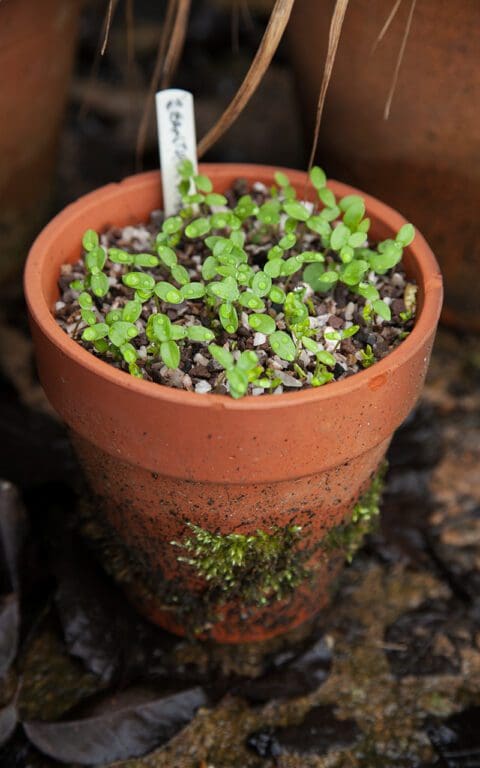
Also in mass production and destined for the wilder places are some locally sourced bluebells grown from seed. This is not bluebell country, their niche here being on the heaviest clay in the woods and not where it is too rich and competitive. I have been studying our ground to find the place where I imagine they might thrive, even just in pockets so that we have some pools of blue in the coppice.
Then there are the bulbs that are too expensive to buy in bulk and that I hanker for en masse. Camassia leichtlinii originally bought as ‘Amethyst Strain’ from Avon Bulbs and now renamed Avon Stellar Hybrids, are destined for the ditch. Well-named for their colour range of mauves and lavenders, their propensity to rampant seeding in the open ground of the garden will be mediated by the competition of grass. Tulipa sprengeri (at a prohibitive £5 a bulb) comes easily from seed if you are prepared to wait, as does the pale-flowered form of the native early winter aconite, Eranthis hyemalis ‘Schwefelglanz’. I plan for sheets of this butter-yellow form one day, in the places that are too damp for the snowdrops, but on the same trail and flowering with them in January. Though the wait is usually five years to flower for most of the bulbs, the beauty of sowing every year means that there is always a tray finishing the relay and ready to join the land of plenty.
Words: Dan Pearson | Photographs: Huw Morgan
Published 30 January 2021
Although the snow from last weekend has all but gone, the drifts that stubbornly mark the lee of the hedges on the coldest slopes are a reminder that winter’s grip is still apparent. The primroses, however, have a schedule to keep and have responded with gentle defiance. The first flowers were out just days after the first thaw to light the dark bases of the hedgerows, and now they are set to make this first official week of spring their own.
Since arriving here, we have done our best to increase their domain. Although they stud the cool, steep banks of the lanes, they were all but absent on the land where the cattle had grazed them out. Save for the wet bank above the ditch where they were protected from the animals by a tangle of bramble. We noted that they appeared in this inaccessible crease with ragged robin, angelica and meadowsweet. Four years ago we fenced the ditch along its length to separate the grazing to either side and since then have done nothing more than strim the previous season’s growth in early January to keep the brambles at bay.
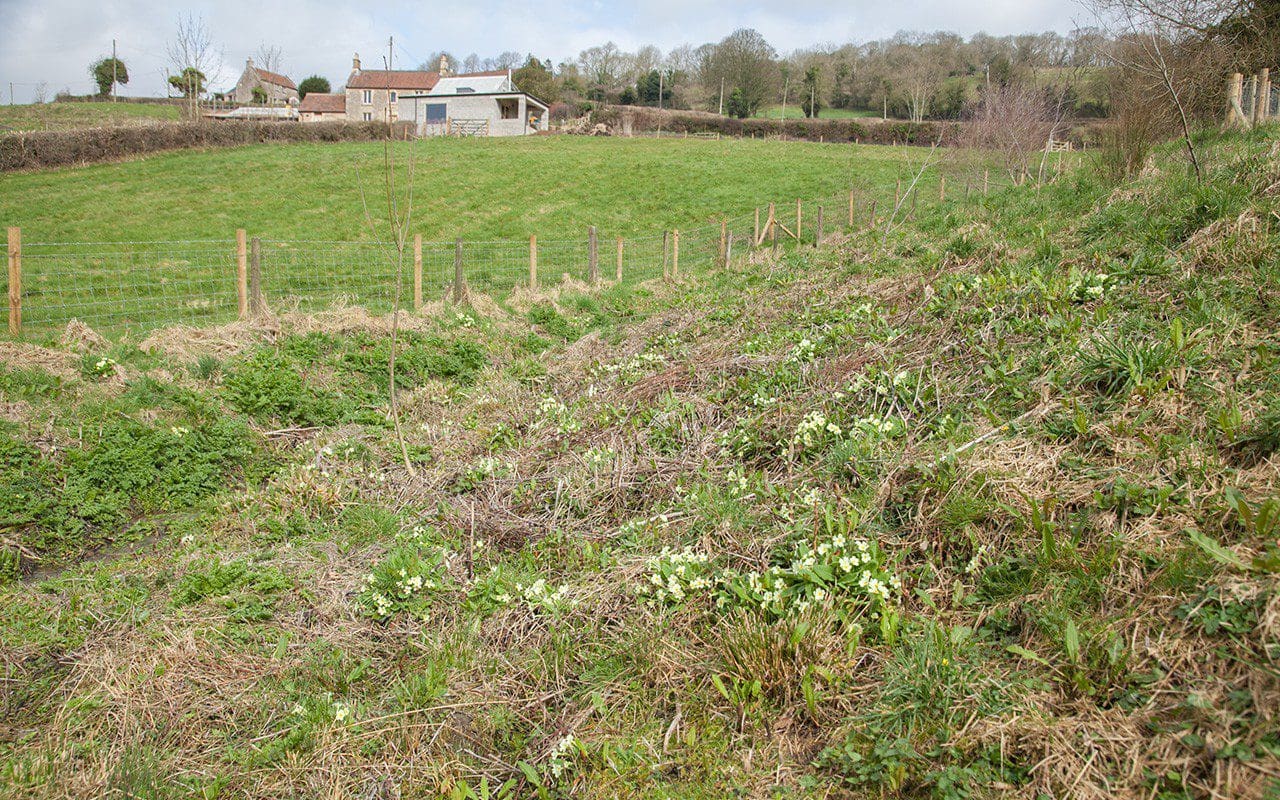
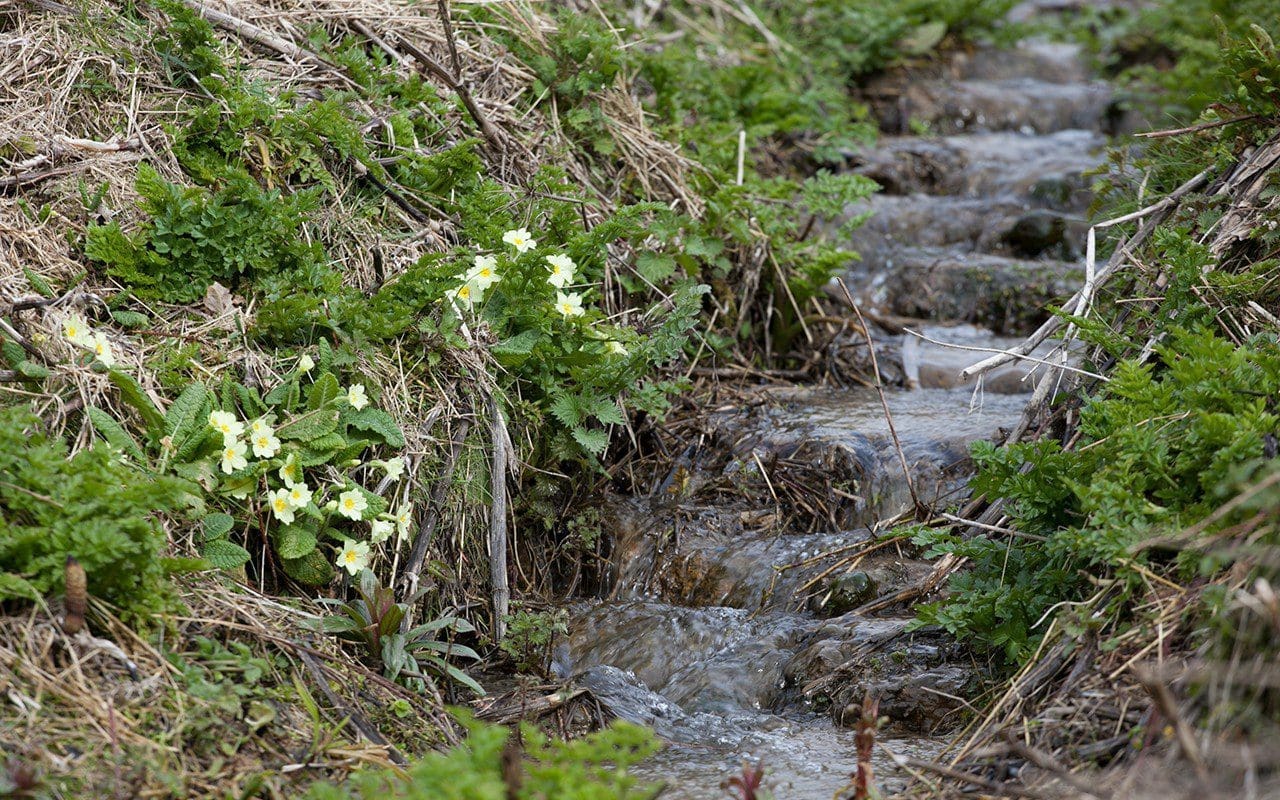
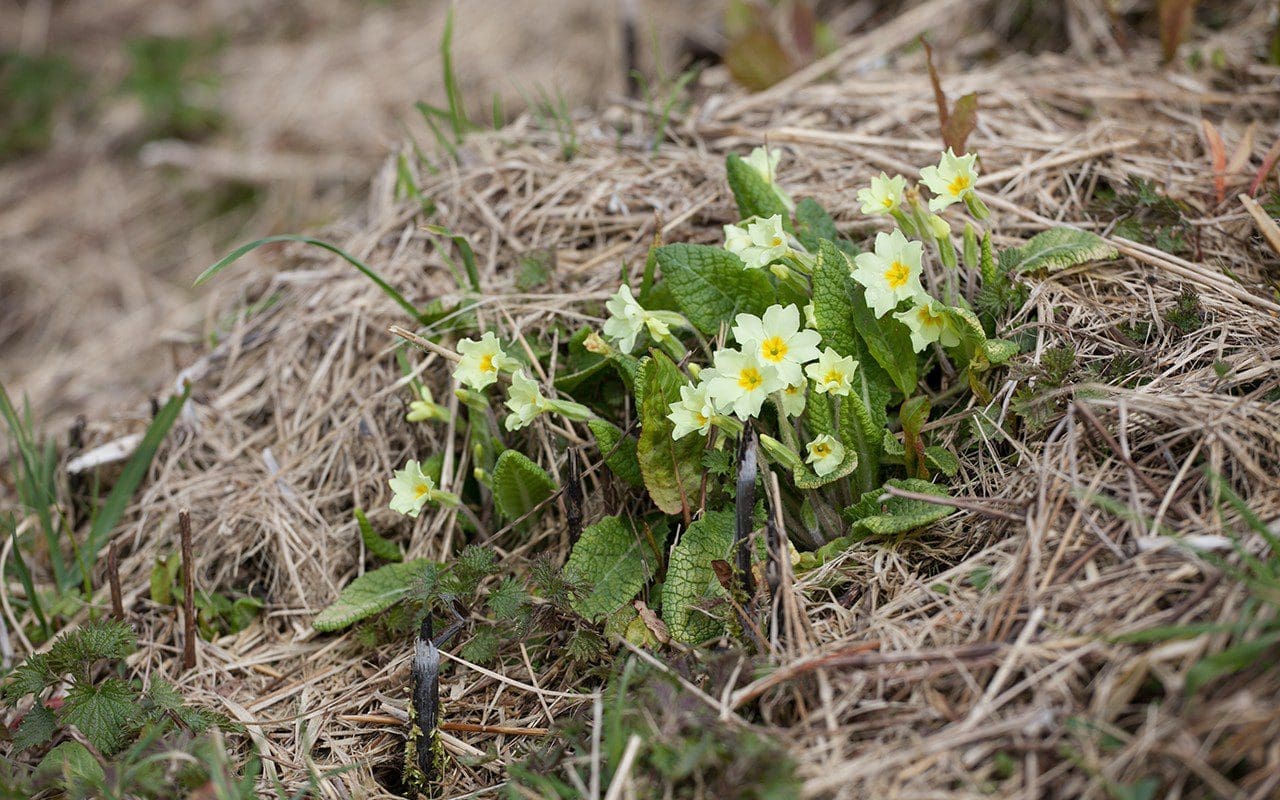 Primroses (Primula vulgaris) colonise the banks above the ditch
Primroses (Primula vulgaris) colonise the banks above the ditch
The new regime has seen a slow but gentle shift in favour of increased diversity. Though the brambles had protected them in the shade beneath their thorny cages, now that they have been given headroom the primroses have flourished. Their early start sees them coming to life ahead of their neighbours and, by the time they are plunged once more into the shade of summer growth, they have had the advantage. Four years on we can see them increasing. The mother colonies now strong, hearty and big enough to divide and distinct scatterings of younger plants that have taken in fits and starts where the conditions suit them.
Each year, as soon as we see the flowers going over, we have made a point of dividing a number of the strongest plants. It is easy to tease them from their grip in the moist ground with a fork. However, I always put back a division in exactly the same place, figuring they have thrived in this spot and that it is a good one. A hearty clump will yield ten divisions with ease, and we replant them immediately where it feels like they might take. Though they like the summer shade, the best colonies are where they get the early sunshine, so we have followed their lead and found them homes with similar conditions.
The divisions taken from the heavy wet ground of the ditch have been hugely adaptable. The first, now six years old and planted beneath a high, dry, south-facing hedgerow behind the house, have flourished with the summer shade of the hedge and cover of vegetation once the heat gets in the sun. It is my ambition to stud all the hedgerows where we have now fenced them and they have protection from the sheep. Last year’s divisions, fifty plants worked into the base of the hedge above the garden, have all come back despite a dry spring. Their luminosity, pale and bright in the shadows, will be a good opening chorus in the new garden. The tubular flowers can only be pollinated by insects with a long proboscis, so they make good forage for the first bumblebees, moths and butterflies.
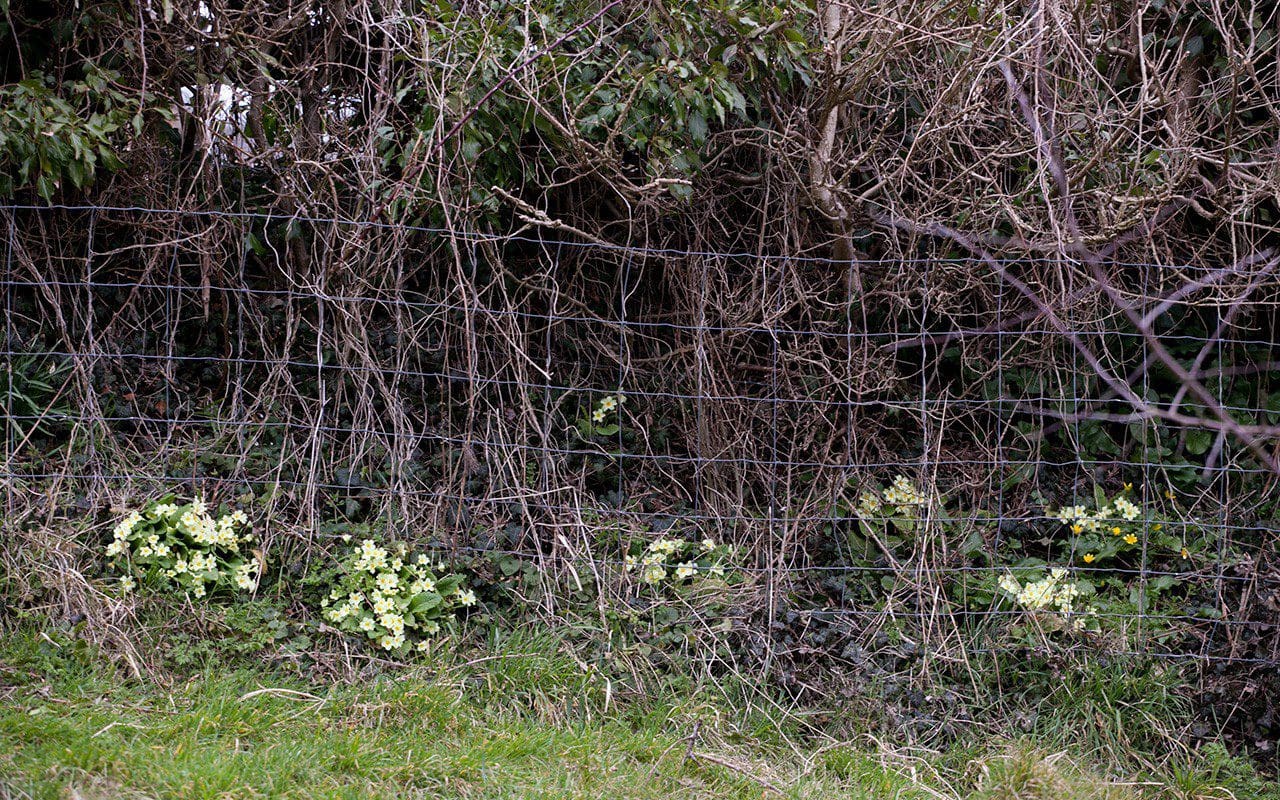
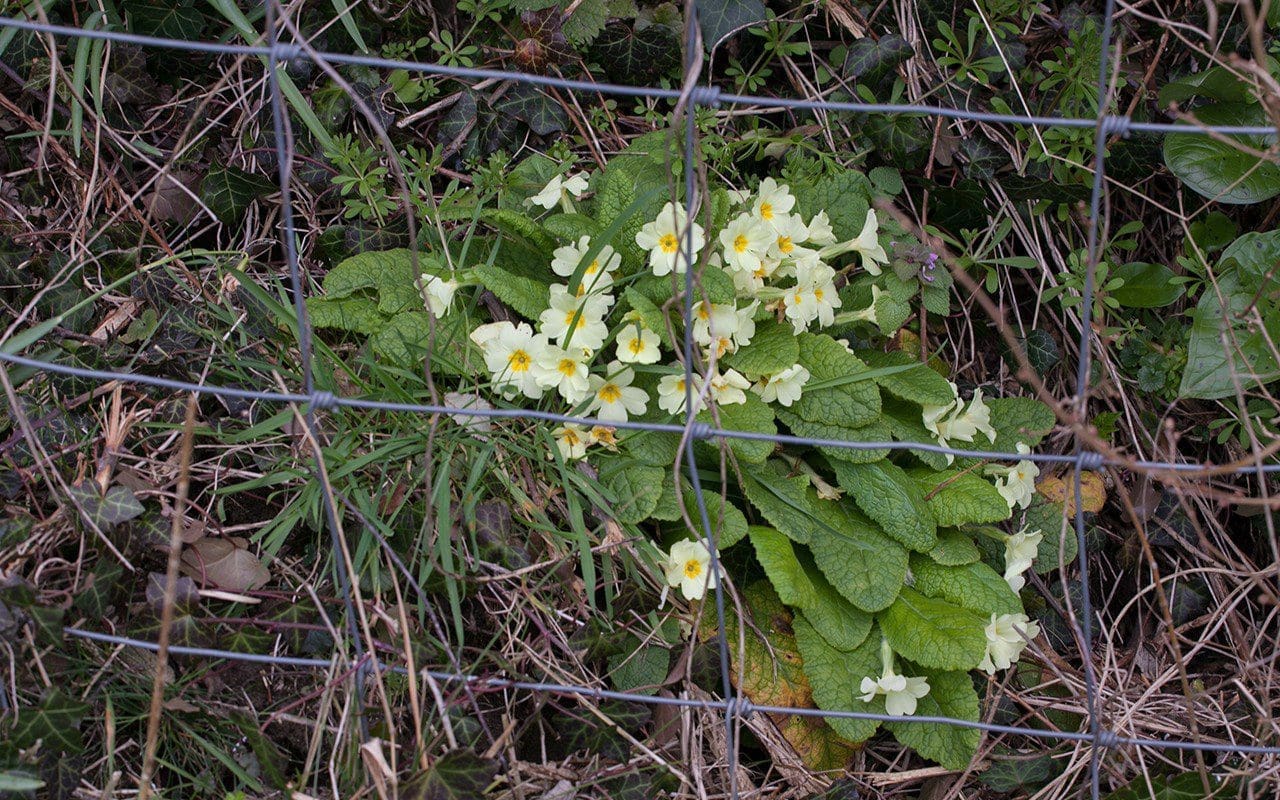 The six year old divisions at the base of the south-facing hedge behind the house
The six year old divisions at the base of the south-facing hedge behind the house
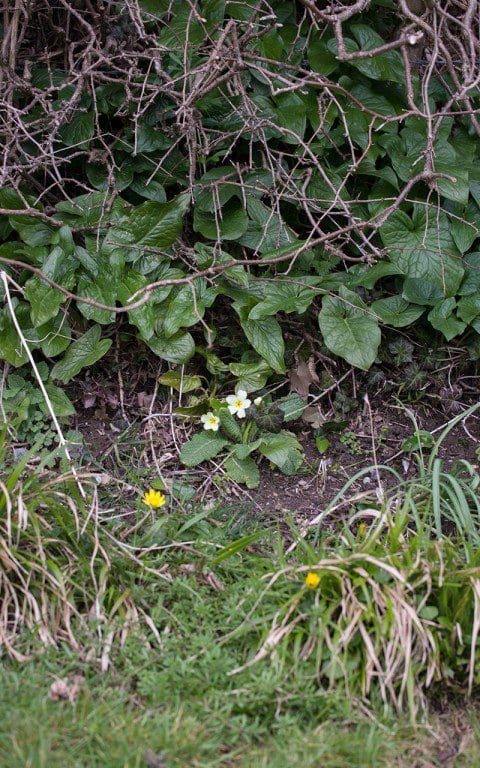 A one year old division at the base of the hedge above the garden
A one year old division at the base of the hedge above the garden
By the time the seed ripens in early summer, the primroses are usually buried beneath cow parsley and nettles, so harvesting is all too easily overlooked. However, last year I remembered and made a point of rootling amongst their leaves to find the ripened pods which are typically drawn back to the earth before dispersing. The seed, which is the size of a pinhead and easily managed, was sown immediately into cells of 50:50 loam and sharp grit to ensure good drainage. The trays were put in a shady corner in the nursery area up by the barns and the seedlings were up and germinating within a matter of weeks. As soon as the puckered first leaves gave away their identity, I remembered that it was a pod of primrose seed that had been my first sowing as a child. Though I cannot have been more than five, I can see the seedlings now, in a pool of dirt at the bottom of a yoghurt pot. The excitement and the immediate recognition that, yes, these were definitely primroses, was just as exciting last summer as it was then.
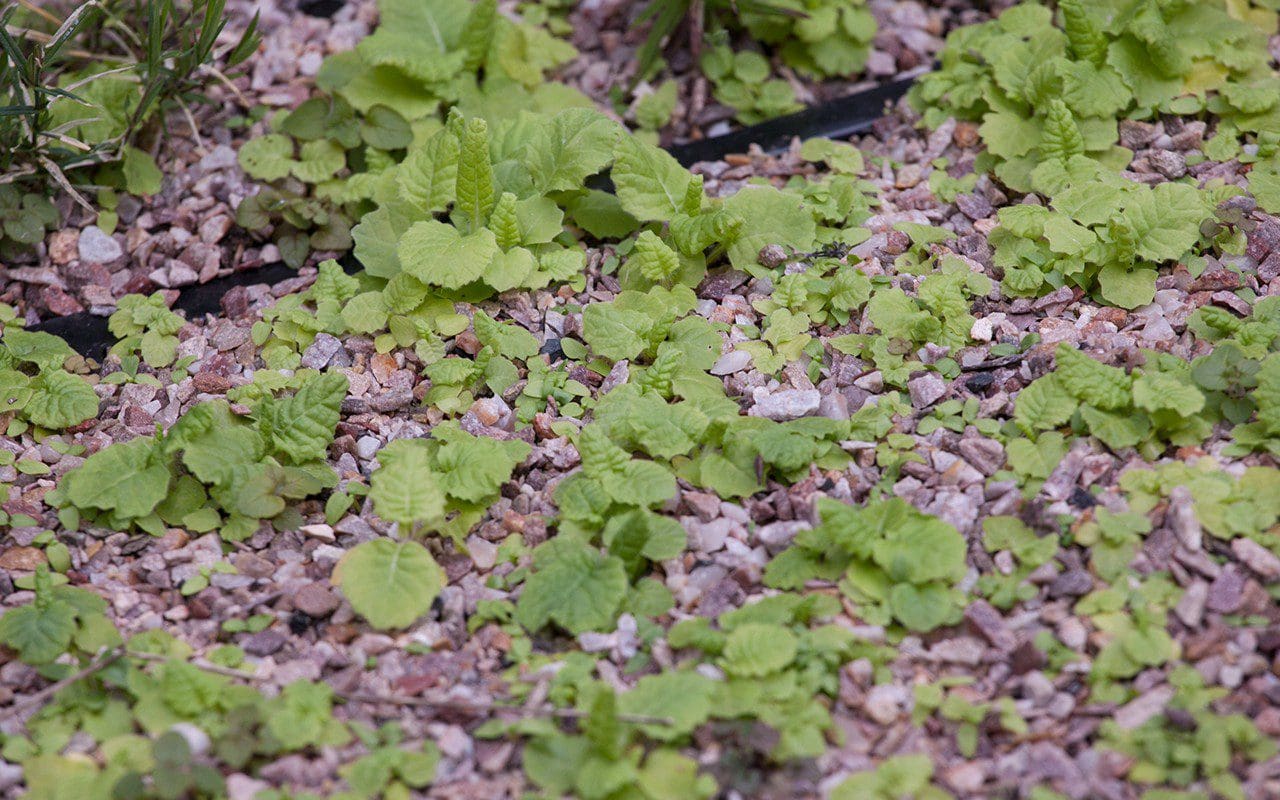 Primrose seedlings
Primrose seedlings
The young plants will be grown on this summer and planted out this coming autumn with the promise of winter rain to help in their establishment. I will make a point of starting a cycle of sowings so that, every year until I feel they are doing it for themselves, we are introducing them to the places they like to call their own. The sunny slopes under the hawthorns in the blossom wood and the steep banks at the back of the house where it is easy to put your nose into their rosettes and breathe in their delicate perfume. I will plant them with violets and through the snowdrops and Tenby daffodils, sure in the knowledge that, whatever the weather, they will loosen the grip of winter.
Words: Dan Pearson / Photographs: Huw Morgan
Published 24 March 2018
Yellow breaks with winter. Soft catkins streaming in the hazel. Brightly gold and blinking celandines studding the sunny banks. They are shiny and light reflecting and open with spring sunshine. As strong as any colour we have seen for weeks and welcome for it.
There is more to come, and in rapid succession, now that spring is with us. The first primroses in the hollows and dandelions pressed tight in grass that is rapidly flushing. Daffodils in their hosts, pumping up the volume and forsythia, of course, at which point I begin to question the colour, for yellow has to be handled carefully.
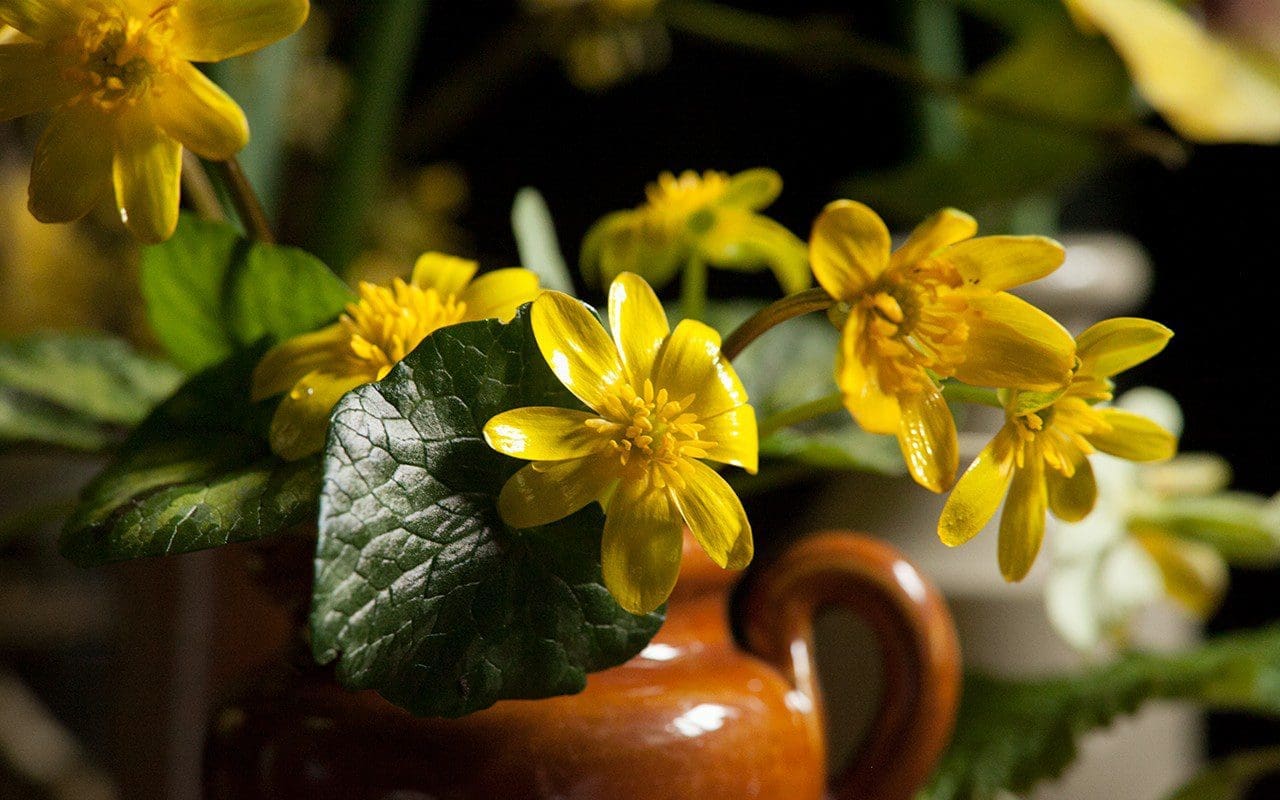 Lesser Celandine – Ranunculus ficaria
Lesser Celandine – Ranunculus ficaria
In all my years of designing it is always yellow that clients most often have difficulty with. ‘I really don’t like it’. ‘I don’t want to see it in the garden’. ‘Only in very small amounts’. Strong language which points to the fact that it prompts a reaction. Colour theory suggests the yellow wavelength is relatively long and essentially stimulating. The stimulus being emotional and one that is optimistic, making it the strongest colour psychologically. Yellow is said to be a colour of confidence, self-esteem and emotional strength. It is a colour that is both friendly and creative, but too much of it, or the wrong shade, can make you queasy, depressed or even turn you mad.
Whether I entirely believe in the thinking is a moot point, but I have found it to be true that yellow is a positive force when used judiciously. My first border as a teenager was yellow. I experimented with quantity and quality and by contrasting it with magenta and purple, it’s opposites. Today I weave it throughout the garden, using it for its ability to break with melancholy; a flash of Welsh poppy amongst ferns or a carefully selected greenish-yellow hellebore lighting a shaded corner.
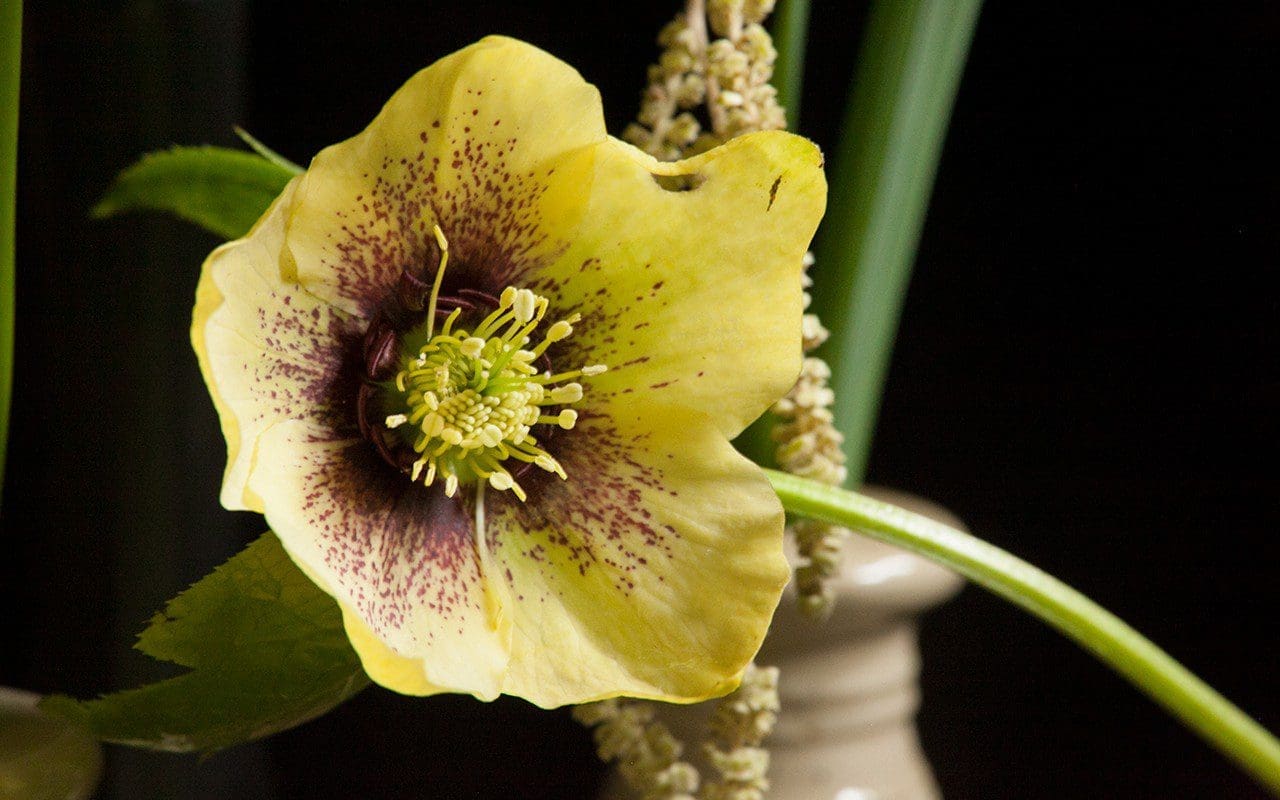 Helleborus x hybridus Ashwood Selection Primrose Shades Spotted
Helleborus x hybridus Ashwood Selection Primrose Shades Spotted
I remember talking to the textile designer, Susan Collier, about the use of yellow in her garden in Stockwell. She had repeated the tall, sulphur-yellow Thalictrum flavum ssp. glaucum throughout the planting and explained how she used it to draw the eye through the garden. ‘Yellow in textile design is extraordinarily persistent. It is noisy, but it lifts the heart. It causes the eye to wander, as the eye always returns to yellow.’
At this time of year, I am happy to see it, but prefer yellow in dashes and dots and smatterings. I will use Cornus mas, the Cornelian cherry, rather than forsythia, and have planted a little grove that will arch over the ditch in time and mingle with a stand of hazel. The fattening buds broke a fortnight ago, just as the hazel was losing its freshness. Ultimately, over time, my widely spaced shrubs will grow to the size of a hawthorn, the cadmium yellow flowers, more stamen than petal, creating a spangled cage of colour, rather than the airless weight of gold you get with forsythia.
We have started splitting the primroses along the ditch too. I hope they will colonise the ground beneath the Cornus mas. I have a hundred of the Tenby daffodil, our native Narcissus obvallaris, to scatter amongst them. The flowers are gold, but they are small and nicely proportioned. Used in small quantity and widely spaced to avoid an obvious flare, they will bring the yellow of the cornus to earth.
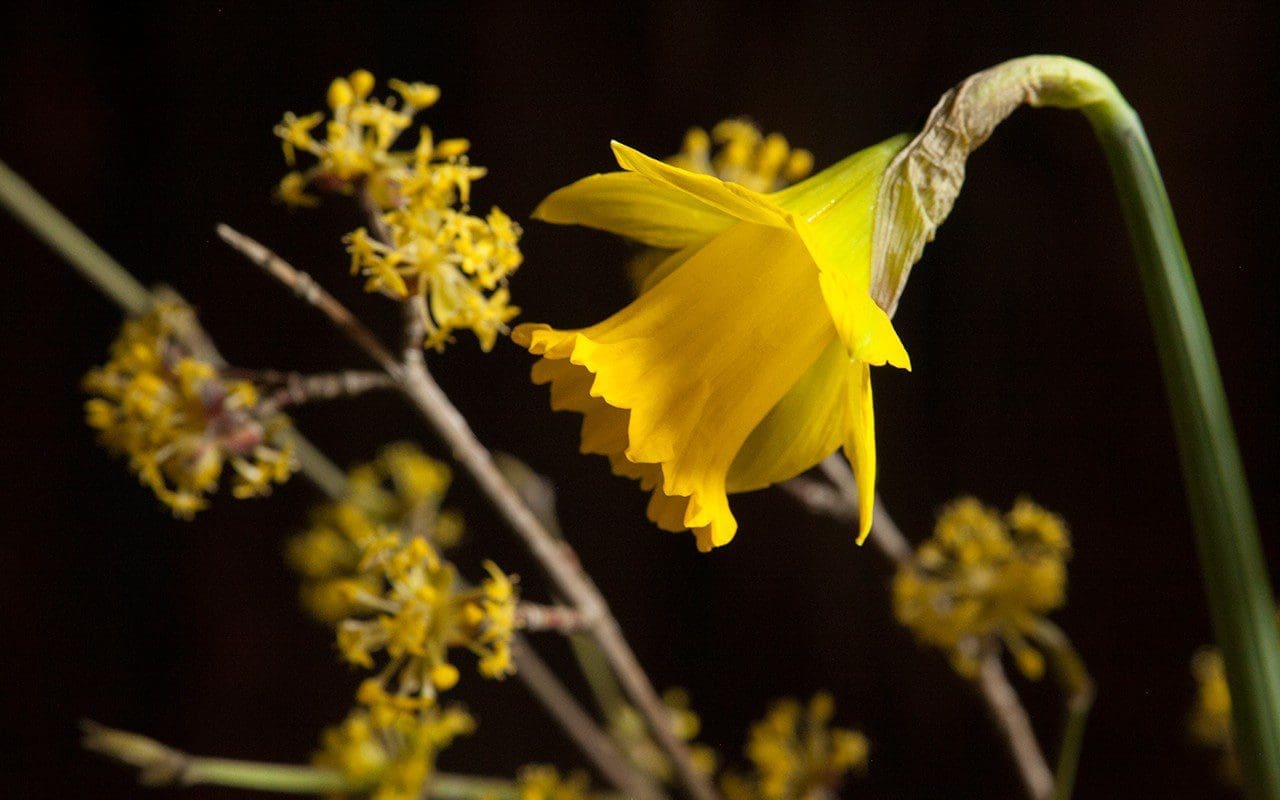 Narcissus obvallaris with Cornus mas (Cornelian cherry)
Narcissus obvallaris with Cornus mas (Cornelian cherry)
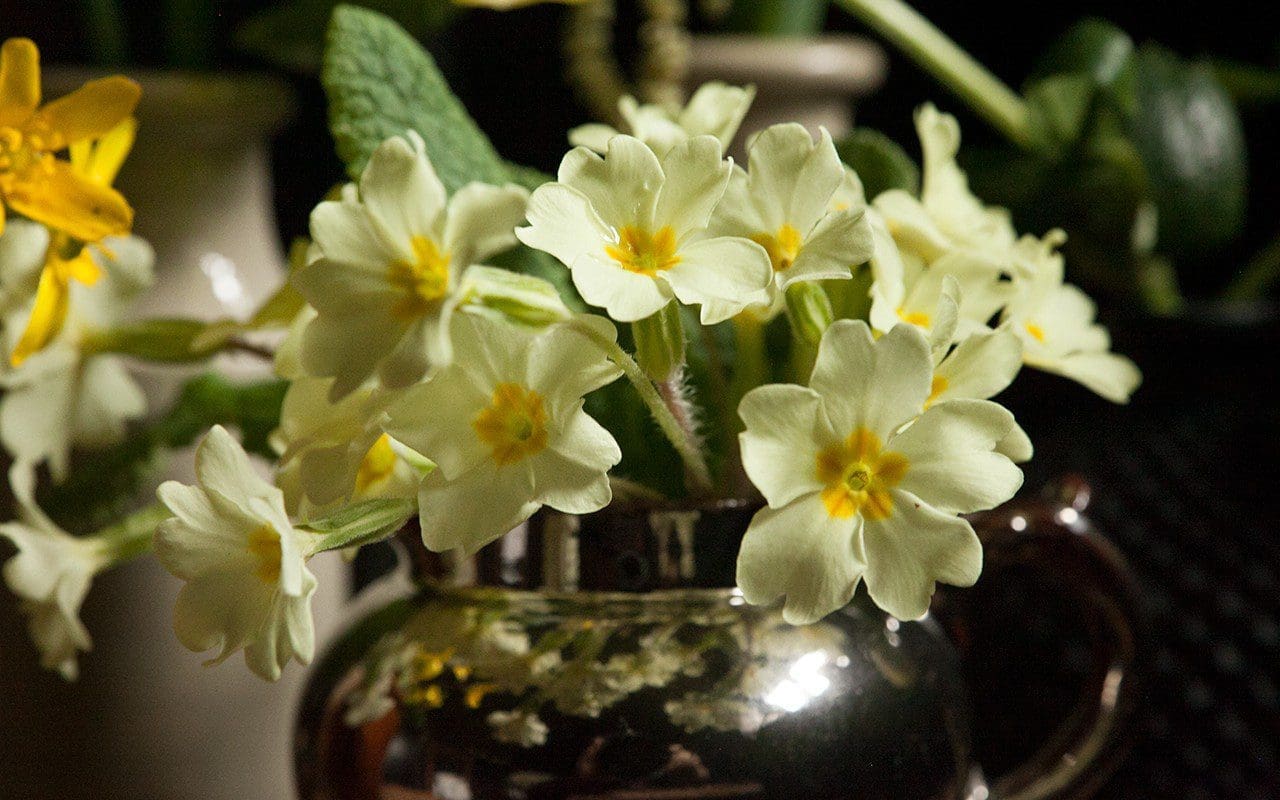 Primrose – Primula vulgaris
Primrose – Primula vulgaris
After several years of experimenting with narcissus, I have found that they are always best when used lightly and with the stronger yellows used as highlights amongst those that are paler. N. bulbocodium ‘Spoirot’, a delightful pale hoop-petticoat daffodil is first to flower here and a firm favourite. I have grown them in pans this year to verify the variety, but will plant them on the steep bank in front of the house where, next spring, they will tremble in the westerly winds.
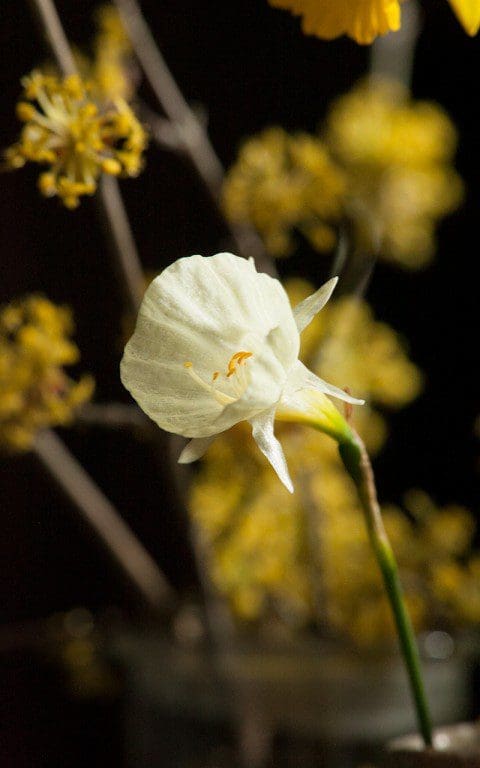 Narcissus bulbocodium ‘Spoirot’
Narcissus bulbocodium ‘Spoirot’
The very first of the Narcissus x odorus and Narcissus pallidiflorus are also out today, braving a week of overcast skies and cold rain. The N. pallidiflorus were a gift from Beth Chatto. She had been gifted them in turn by Cedric Morris, who had collected the bulbs on one of his expeditions to Europe. The flowers are a pale, primrose yellow, the trumpet slightly darker, and are distinguished by the fact that they face joyously upwards, unlike their downward-facing cousins.
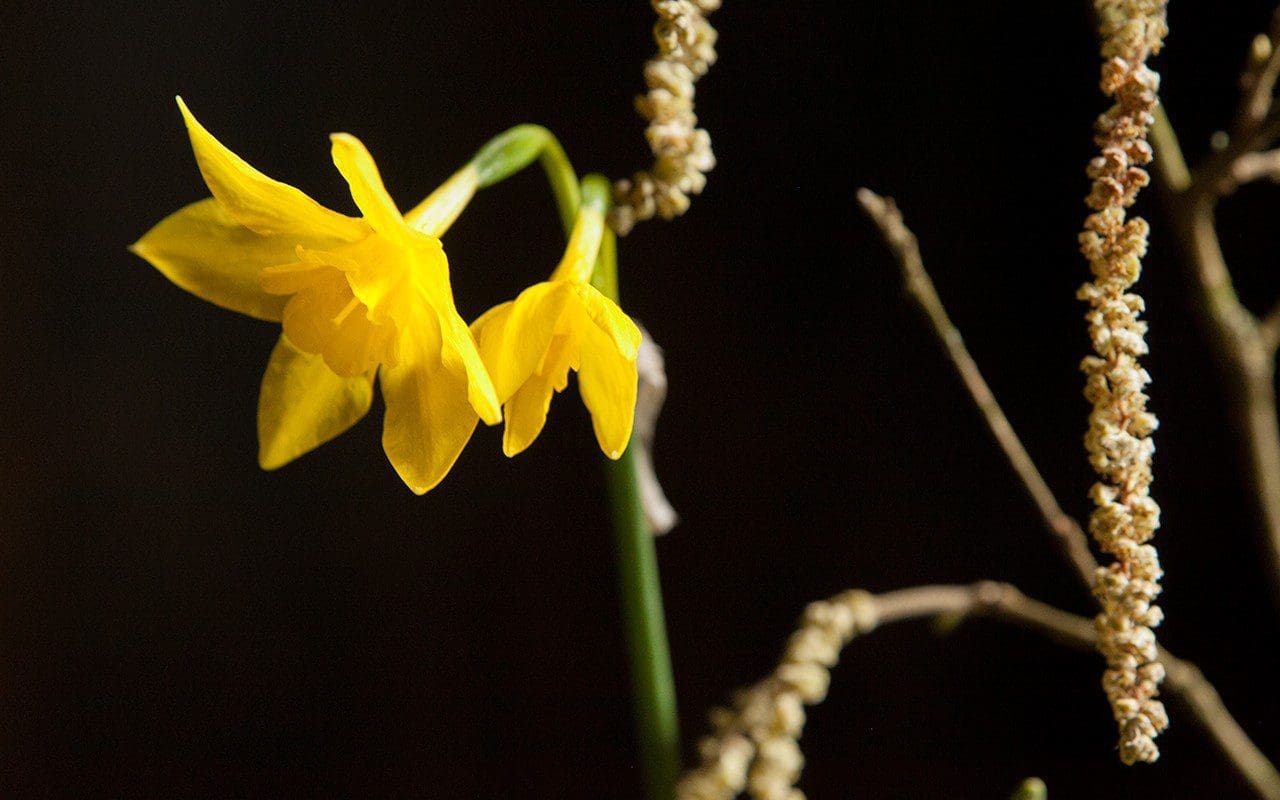 Narcissus x odorus
Narcissus x odorus
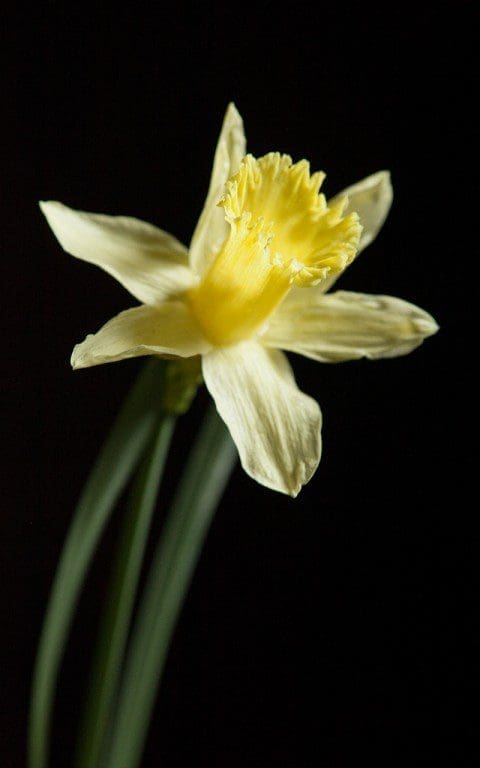 Narcissus pallidiflorus
Narcissus pallidiflorus
Our other native daffodil Narcissus pseudonarcissus has a trumpet the same gold as N. obvallaris, but with petals the pale lemon hue of N. pallidiflorus. It has an altogether lighter feeling than many of the named hybrids for this gradation of colour. We were thrilled to see a huge wild colony of them in the woods last weekend, spilling from high up on the banks, the mother colony scattering her offspring in little satellites. This is how they look best, in stops and starts and concentrations. I am slowly planting drifts along the stream edge and up through a new hazel coppice that will be useful in the future. A move that feels right for now, with all the energy and awakening of this new season.
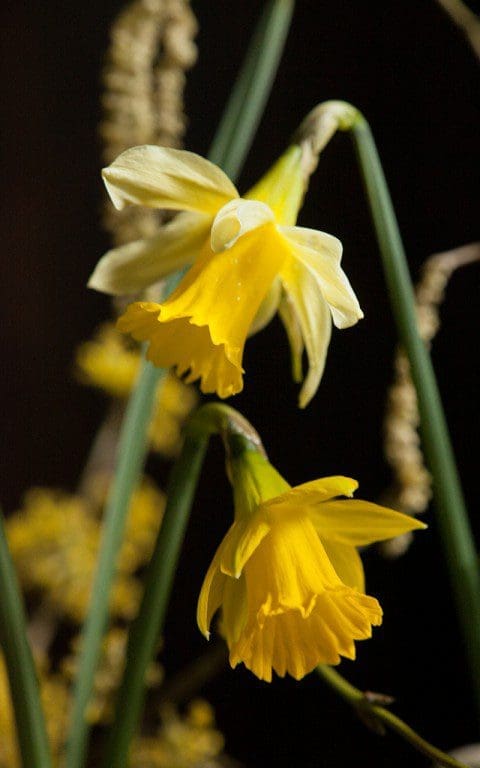 Narcissus pseudonarcissus (top), Narcissus obvallaris (bottom)
Narcissus pseudonarcissus (top), Narcissus obvallaris (bottom)
Words: Dan Pearson / Photographs: Huw Morgan
We are sorry but the page you are looking for does not exist. You could return to the homepage